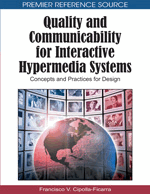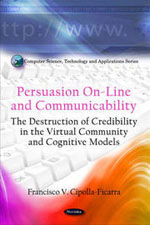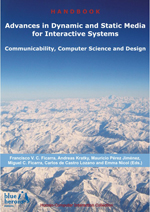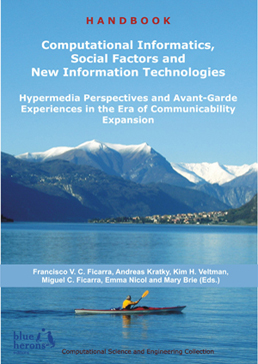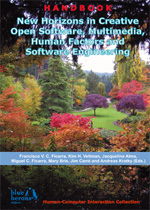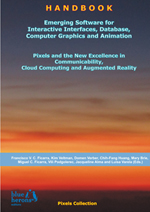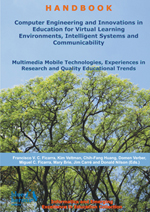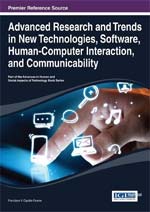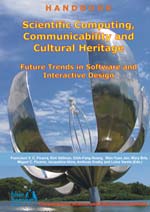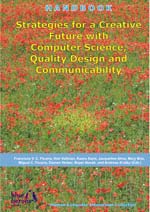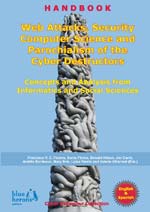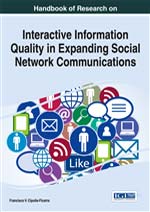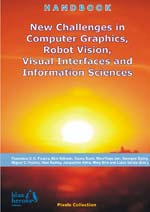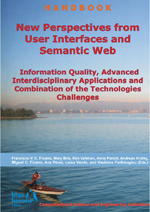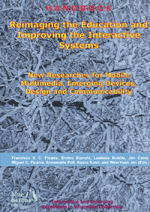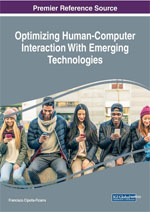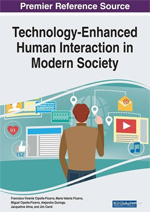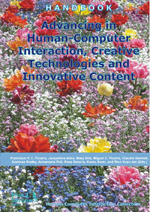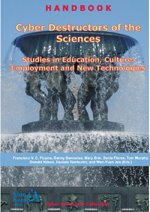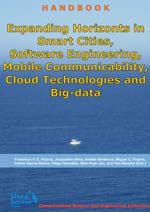Expanding Horizonts in Smart Cities, Software Engineering, Mobile Communicability, Cloud Technologies, and Big-data
:: Computational Science and Engineering Collection ::
:: Revised Selected Chapters ::
Main Editor: Francisco V. C. Ficarra
Co-editors: Jacqueline Alma (Vancouver, Canada), Amélie Bordeaux (Lyon, France), Miguel C. Ficarra (Spain and Italy), Carlos García Garino (Mendoza, Argentina), Diego González (Bologna, Italy), Wen-Yuan Jen (Miaoli, Taiwan), and Tom Murphy (Dublin, Ireland)
Editorial Assistants: Mary Brie (La Valletta, Malta) and Luisa Varela (Perpignan, France)
Book Details
• ISBN: 978-88-96471-72-2 :: DOI: 10.978.8896471/722
• Publisher: Blue Herons Editions
• Location: Italy (Bg)
• Subjects: Communicability, Design, Software, Hardware, Database, Amerindex, Information
• Subjects: Education, Computer Science, Interface, Quality, Human Factors, Metrics, Web
• Subjects: Communications Review, New Technologies, Design-Based Learning, Smart City
• Subjects: Quantum Computing, Nanotechology, Multimedia, ICT, Google, H-index, Health
• Subjects: 1D, 2D, Fractal Signals, SAR Images, Linkedin, Employment, G-Factor, Twitter
• Subjects: Big Data, Visualization, Querying, Intelligent Systems, Youtube, HCI, Safety, AR
• Subjects: System Thinking, Assessment, Statistics, Fourier Transform, GUI, Data Storage
• Subjects: Network Analysis, GIS, Medical Research, Human Machine Systems, Acoustics
• Subjects: AI, Human Behaviour, Children’s Emotion, Adaptive Automation, Tempogram, UX
• Subjects: 3D, Mixed Reality, Smartphone, Social and Technological Context, Food Policy
• Subjects: R&D, Mobile Cloud Computing, Scientific Publications, Indexation, Parochialism
• Copyright: 2018
• Collection: Computational Science and Engineering
• Series volume: IV
• Publication date: December, 2018
• Binding: Paperback
• Grade level: General
• Language: English
• Illustrations: Yes
• Colour: Yes
• Pages: 212
• Dimensions: 11.41x8.26x0.5 in. 1.22 lbs. :: 290x210x13 mm. 552 gr.
Preface
While there’s life, there’s hope.
Theocritus (315 a.C. – 260 a.C.)
The computerized societies of the 21st century are going through a period of great uncertainty towards the horizons drawn as limits to improve the quality of living of their inhabitants in 2020. A myriad projects have been developed since the start of the financial crisis of the new millennium.
However, the ordinary citizen does not really see the advantageous and positive results of the intersection between some new technologies (e.g., domotics, robotics, mobile devices in healthcare, etc.) and daily life (e.g, protection of the environment, urban infrastructure, free education and health for all, etc) for best quality of life. Quite the opposite, the digital divide increases with every passing hour, between the educational-scientific context and the average citizens, who sustain such research. The importance of the context, starting with nature and the inhabitants that surround us and who have been marginalized or excluded with the last global crisis, although the upswings in the field of ICTs (information and communication technologies) are not evolutionary but rather, revolutionary.
Terms such as disability, feminism, gender equality, volunteerism, etc. have served to mask the intentions of the real perpetrators of labor marginalization, social exclusion, racial discrimination, intolerance, among others, in some universities (e.g., EU Mediterranean area, in 1990–2005) for place of birth, economic status, chauvinistic reasons, etc. Perpetrators who belong to the educational, cultural and scientific sector of those communities blinded by protectionism, the rise of nationalisms, pseudo autonomous movements, etc. In other words, a reality that can be summed up with an old saying that says, "divide and prevail."
Removing those masks and returning to focus the interests of new technologies in the common good of the inhabitants of modern societies, revaluing nature, culture, science, education, new technologies, etc., it is not an easy task, as it may be to face the issue of climate change in the short term. For example, the consequences of climate change will make the latest technological instruments be adapted to the new demands of the users in the global village. Many R&D projects, financed by the common funds in the EU under the Horizon 2020 label, were not only obsolete since their inception due to a lack of panoramic and creative vision of the future, but they have also allowed the detection of those “ideal or great” human networks to obtain financial funds. And yet, when it comes to “theoretical + practical” solutions, they simply do not work. That is, general and particular objectives stray totally away from the real and non-virtual context of the human being next decade.
Precisely, the notion of the "real context" becomes the central axis of the success of the new information and communication technologies of the new millennium. However, since decades only a vertical structure of power can be seen, that is, the one between the domineers and the dominated, which in the new decade we could call between "colonizers" and "colonized" because their contexts are usually diametrically opposed, favoring and enhancing not a digital divide, but rather an abysmal gap or sidereal chasm. An abysmal gap that starts at the time of conception and design of technological instruments and ends with the software for its operation.
In this fourth handbook of "Computational Science and Engineering Collection", each of the keywords, conclusions, lessons learned and future lines of research, aim to be a valid guide for students, teachers and professionals in the second decade of the new millennium. Furthermore, the studies collected in the handbook have been evaluated and corrected prior to publication in an anonymous way by an international scientific committee. In some cases, these resarch works have been put forward orally –papers, short papers, research-in-progress, posters, etc., with their corresponding demos. In other words, 45 – 75 minutes for an oral presentation –including time for questions, that is, accompanied with practical/theoretical study cases in international events. The international conferences, workshops and symposiums are: ADNTIIC (International Conference on Advances in New Technologies, Interactive Interfaces and Communicability), CCGIDIS (International Symposium on Communicability, Computer Graphics and Innovative Design For Interactive Systems), ESIHISE (International Conference on Evolution of the Sciences, Informatics, Human Integration and Scientific Education), HCIHEART (International Conference on Human-Computer Interaction, High Education, Augmented Reality and Technologies), HCITISI (Argentine Conference on Human-Computer Interaction, Telecommunications, Informatics and Scientific Information), HCITOCH (International Workshop on Human-Computer Interaction, Tourism and Cultural Heritage), HIASCIT (International Conference on Horizons for Information Architecture, Security and Cloud Intelligent Technology), MSIVISM (International Conference on Multimedia, Scientific Information and Visualization for Information Systems and Metrics), QUITANS (International Conference on Quantum Information Technologies Applied to Nature and Society), RDINIDR (International Conference on Research and Development in Imaging, Nanotechnology, Industrial Design and Robotics), and SETECEC (International Conference on Software and Emerging Technologies for Education, Culture, Entertainment, and Commerce). Lastly, this introduction provides a brief presentation of the chapters, highlighting their main contributions:
In this chapter “Computation and Estimation of Self Similarity Parameters in Images and Signals”, the authors José Luis Hamkalo, Juan Miguel Medina, Agustín Bertrán Mailing, Fernando Rubén Dobarro, Daniel Fernández and Bruno Cernuschi Frías, present estimators of parameters of self-similarity in a probabilistic sense in fractals. In it, 1D and 2D synthetic generation models and their computational implementation were considered. In addition, the estimator for the 1D case was implemented, thus verifying a high linearity and robustness in the estimation. Also, the possible application to experimental, synthetic data and its computational implementation to the problem of estimation and detection in real images and signals and its application to the detection of oil spills at sea is discussed. Finally, the advances in the theoretical framework for the 2D case and with the computational synthesis of 2D images that will be of fundamental importance for the validation of the models and tools created are announced.
The authors of the chapter “Amerindex” present a valid alternative that allows to gather and index research and/or scientific papers, in a logical, democratic, economic, transparent way and with zero “G” factor (G = Garduña). The work describes in detail a real experience, where various methods of the social sciences have been used to collect information over a decade, verify hypotheses and issue conclusions. Francisco V. C. Ficarra and Alejandra Quiroga elaborate a broad state of the art, within the international editorial context, at the time of receiving and indexing research papers, related to education and computer engineering and/or bachelor's degrees. The study focuses on the latest generation interactive systems, from the design phase to programming, with special attention to communicability, human-computer interaction, interfaces, among other topics. In short, the study summarizes and demonstrates the existing alternatives, given the vertical model, in the indexation of scientific articles, in several European databases, related to computer science and ICTs, as well as, the possibility of stopping pranksters and unsavoury characters that swarm freely in the context of the new technologies, either by submitting the same works in several publishing channels (workshops, conferences, symposiums, magazines, journals, books, handbooks, etc.) or even attending international events in order to sabotage and destroy them.
“A New Electronic Board for Climate Records Assessment: ICT and Educational Implications” is a project presented by Andrea Antonini, Luca Bini, Giuseppe Floridia, Gianni Camici, Martino Coppola, Alessandro Pinto, Gabriele Rafanelli and Ilaria Cantini, related to climate change, its impact on agriculture, and the use of new technologies (low-cost meteorological station, for example) to take measures in this regard. The main objective of the project was to develop a low cost weather station to be used in farms for weather monitoring, for example. The state of the art allows to know the paths followed by its authors at the time of choosing the software and hardware instruments that they would use in the project, announcing its main advantages. And that to such extent that an Arduino-based control system has been implemented. Furthermore, the fully automatic equipment broadcasts recorded data in real time using wi-fi, and a remote system that collects data from all the deployed independent measuring points. Simultaneously, future data elaboration and in-field feed-back are being developed. The system architecture is described in detail with schemes and images that facilitate the understanding of the text. It is important to mention that it is a work that the authors have developed within the educational context but outside the university classrooms. Consequently, it constitutes an interesting research to include the new generations in current issues and that potentially, the labor market will demand theoretical-practical knowledge of the kind that has been developed in the current project.
In the work called “Quantifying the Impact of Supermarket Distance on Obesity in Greater London, England: Looking for a Golden Access Measure”, its authors: Elzbieta Titis, Henry Crosby, Rob Procter, Stephen Jarvis, and Thijs van Rens, highlight the importance of health, taking into account the distances between the residence of the population and the food supply centers, such as grocery stores, supermarkets, etc. in the city of London and its surroundings. The methods of data collection of the social sciences, statistical techniques, the GIS, the various types of access of people to the centers of sale of food products (on foot, by bicycle, car, etc.), obesity of the population, occupy the central axis of the current investigation, whose keywords can be summarized as follows: Food deserts, food access, supermarkets, obesity, GIS, network analysis, distance calculation, density-based measures, travel modes. The main areas are disclosed in the following sections: Food deserts metrics; Food deserts, Socioeconomic status and obesity; Data description; Data collection and exploration; Missing data; Methodology; Distance matrix and service area; Distance measures; and Regression procedure. The conclusions section allows to establish the results obtained as the future steps to follow by their authors.
System thinking, agent-based modeling, agent-based simulations and real data, food policy, dynamic behavioral model of shopping choice, are some of the main words and phrases that summarize the research called: “Building Agent-Based Model for Food Policy Interventions: The Case of Food Deserts in Greater London, England” and whose authors are Elzbieta Titis, Henry Crosby, Rob Procter, Stephen Jarvis, and Nathan Griffiths. In it, the authors showcase a methodology to build a model useful to policymakers when proposing policy interventions, and to produce the data which can lead to improvements in the quality of data collected for future food deserts research. Field work is located in the capital of England and surrounding areas. One of the objectives of this work is to reduce the costs of the health service in matters related to health and overweight. The study examines in detail each of the variables that make up the problem that they intend to solve such as physical characteristics, social context, physical environment, among others, which has allowed developing a reliable model, when obtaining the first results. Results that are explained in the conclusions, as well as in future lines of research.
Through four key words or main notions, such as Tempogram; Matching pursuit; Tempo dictionary, and Fourier transform, and with the title “Tempogram Based on Matching Pursuit”, their authors Gui Wen-ming, Zhao Hai-feng, and Tao Yu-ting present a promising tempogram algorithm. The tempogram created by this algorithm has better resolution and stronger sparsity than those of the traditional algorithms. In this sense, the work of comparisons in the introduction and in the motivations to carry out the present investigation that can be considered as a research-in-progress is interesting. The algorithm is based on matching pursuit, a sparse representation algorithm, in which a novel tempo dictionary is designed in the light of the characteristics of tempo and note onset at first, and then matching pursuit is executed on the resampled onset detection function, and finally the tempogram is created by assembling the coefficients of matching pursuit.
In the research work “Communicability and Design for Quantic-Nanotechnological-Self-Sufficient Era” the author describes the first foundations for a new Copernican revolution in the context of software and hardware are set in the interrelation of three notions that will make up a triad of bidirectional relationships among: quantum computing, nanotechology, and artificial intelligence. This triad entails new challenges in the context of the training of new communicability and interactive design professionals to face the new models of interfaces for the future small-sized devices belonging to the new technologies of communication and information. In the current parallel session, we intend to generate a first synergy between the different disciplines of scientific knowledge to find high quality solutions with the least possible cost, always trying to diminish the digital divide among the potential users of the new era. An era where the self-sufficiency of intelligent systems, linked to the high calculation speed of processors and to the tiny dimensions of the hardware, some of them even with the possibility of being implanted in the human body, entail new ways of facing the daily life of the local, national and international societies, in a not very distant future. Once again, the quality of the communication is the 'expansion of the communicability', in each one of the design categories, which in our case we have split for the analysis and study in the following way: conection, content, creativity, layout, navigation, panchronic, and structure. Each one of them will play an essential role for the harmonious progress of humankind based on the common good of the citizens of the 21st century.
The authors of the chapter “Towards Optimum Automation of Human Machine Systems for Maximum Performance” are Arun Balakrishna and Tom Gross. The authors present the direction of future research in the field of optimum Level of Automation (LoA) in Human Machine Systems (HMS) for safety critical domains. Human centered approach is selected for analysis. The research work has an extensive state of the art, where the main concepts are defined correctly. A literature review is conducted in the specified field using a quantitative approach, which gives a clear proof for the direction of future research. A concept oriented approach is selected for review where the selected literatures are analysed based on a set of selected concepts. The research conducted towards each concept is evaluated from the review, research gaps are identified and the direction to which the research has to proceed are identified and justified. Each of its sections is structured correctly and precisely. In this sense, the use of tables and graphs facilitates the valuation of the work developed, through the order followed, at the time of structuring the content, such as the following fundamental sections of the article: Review methodology; review result; Discussion of Review Result, a detailed future research. Moreover, this paper introduces a new method for quantitative literature review which in general can be used for quantitative literature review process.
With the title of “The Role of Children’s Emotion during Design-based Learning Activity” their authors Feiran Zhang, Panos Markopoulos and Tilde Bekker present a research oriented to Design-Based Learning (DBL). In this chapter it is attracting increasing attention because of its potential to support informal learning but also as a way to enhance science and technology education at schools. However, related research has not yet considered the emotions children experience during DBL and how these affect learning outcomes. The authors report a case study that was aimed at developing a deeper understanding of children’s emotional experience during DBL. There is a detailed explanation in each of the phases into which the experiment has been divided. For example, measuring the learner’s emotions, describing the data collection techniques, the process, until the final results are obtained. Children participated in the experiment. In order to assess children’s emotions during DBL lessons. The authors have used a self-reporting non-verbal instrument and a verbal instrument (the Geneva Emotion Wheel, which contains 16 emotions). The conclusions obtained allow the establishment of new action guidelines regarding the measurement of children’s emotions in DBL.
“Web Connectedness Oriented to Smart Cities” is the title with which its authors reveal the evolutionary aspects of the notion of connectivity from the physical and intellectual point of view. The evolutionary process begins with the study of the models of societies of the 21st century that have been conceived at the end of the 20th century. In that vision, each of the aspects of creative communication that have boosted the development of innovative technologies and that are currently in operation in smart cities is investigated. The main axes of the research are: environment, economy, mobility, citizenship and governance. The authors contrast the ideal models conceived by architects, engineers, graphic designers, interactive system programmers, etc. with the technological reality that is available to citizens, through products and services, as well as those that are in the experimentation phase. Finally, there is a section that portrays the content analysis of social media, whose main objective is to verify how successful or remote these contents related to smart cities are, as well as the time that has elapsed between fiction and the technological reality of our days.
The technological advance in smart watches has been the point of attention for Ju-Hwan Lee and Ji-Yeon Lee, who present their first results, under the title: “The Attentional Properties of Haptic Interaction in the User Contexts of Watch-type Wearable Devices in the Entertainment Services.” It is a research work focused on technological aspects and communicability, which is why precision is a common denominator. Under an exhaustive procedure that goes from the selection of the devices to carry out the experiments to the margin of error in the obtained results, the difference in the accuracy of haptic feedback perception in the context of smart device usage can be verified. Therefore, we are facing an investigation based on four fundamental axes such as: Smart watch, wearable, haptic feedback, and attention. In this study, the sensitivity of vibrotactile feedback was compared in the using four experimental contexts divided into the stability of physical movement (sitting or walking) and attentional conditions (concentration or distraction). Finally, the results of the present study help us understand the difference in the characteristics of vibrotactile feedback for enhancing the user experience.
In the study called “The Lack of Scientific Value of the Counter of References in Specialized Database” a first analysis of the scientific-educational context is carried out by Francisco V. C. Ficarra and Donald Nilson, with the rise of social networks. The study begins with an examination of the novel tactics of self-promotion, of the "real" and "virtual" scientists online. Simultaneously, the role of indexes and counters in databases, supposedly scientific, and non-commercial, is investigated, but now on the web, they are treated as an instrument or means of advertising and/or propaganda. That is, contrary to the principles listed in the epistemology of science. A detailed description accompanied by real examples discloses those mechanisms that serve to alter those values, apparently statistical and impossible to manipulate. It is also noted that the purpose of this manipulation is not only to distort the reality of the scientific context, but also enhance the decline of the credibility of scientific knowledge, the epistemology of science, and the promotion of destructive groups. The conclusions obtained have allowed the generation of a first guide or compass, in order to maintain the freedom of scientific knowledge and the dissemination of authentic knowledge, through the Internet and in particular, social networks. The study includes a host of examples from the main applications of social networks or portals aimed at searching for online information, whether in textual, visual (photos, graphics and drawings) and audiovisual format. These examples and the conclusions can be considered as guidelines for future research, given the rise of the problem presented.
In “Education and Mobile Technologies: Thinking and Designing for the Frontier 2050” the author makes a projection of the importance of interactive design, starting with communicability, in mobile technologies applied to education, trying to outline some lines of long-term research, with a deep look at the aspects positive design since the democratization of the Internet in the 1990s. At the same time, there is a reasoned criticism of the scientific chaos of the new millennium, starting with the mechanisms and modus operandi of the pseudoscientists of ICTs, with regard to the destiny of research funding, technology transfers, small business incubators (SMEs), start-ups, local and international conferences or events, etc., under the label of "Horizon 2020". Resources that have been merrily distributed from the European geography to the rest of the world, allegedly for the use of the new technologies in education, research, transfer of knowledge, technology and innovation between university and industry or vice versa, etc. Already in the state of the art it can be seen how these resources have served to finance the tourist mobility of an army of barbarians, under the flattering poster of scientists, in the field of the new technologies and all their derivations. Several documented examples demonstrate the participation of these riot makers in courses, seminars, congresses, workshops or other events, with the sponsorship of prestigious international associations, based in New York and New Jersey, for example. As well as the strategies to "train" the "deformers" of future generations. All this, in the middle of the global financial crisis and not worrying about the daily hardships of their fellow citizens.
Francisco V. C. Ficarra
Rome, Italy (December 2018)
Partial Content On-line (pdf format)
• Front Cover (here)
• Preface :: Acknowledgment (here)
• Chapters :: Final Remarks :: Author Index :: Keywords Index :: References ... (here)
• Back Cover (here)
Additonal Handook Info
• Only paper copy – no digital book on-line and/or off-line –
• Special Price € 95 (expedition cost not included) ... e-Commerce :: Info Form
Welcome to Blue Herons Editions!
The origin of this publishing project is to be found in the Canadian lands, where nature presents itself generous in many places of its wide geography. More...
Education, Communicability, Design, Computer Science, HCI, Computer Graphics and Computer Animation:
We focus on education and new technologies with 38 years long experience. More...
Literature and Journalism:
Intersection between universal literature, local new journalism (true stories), sociology and legal immunity. Two collections:
- Casoncelli Bergamaschi
It is a typical bergamasque dough filled with meat, similar to the raviolis. More...
- Menjar Blanc & Black
It is a typical sweet of the Catalan coast and the Balearic Islands. More...
Others Releases:
See all others new releases in books, CD, DVD, etc. More ...

Call for Papers, Short Papers, Posters, Demos, Research-in-Progress, Workshops, Doctoral Consortium, Hardware & Software Companies - Didactic Demos Sessions ...
ADNTIIC 2018 :: HCITOCH 2018 :: SETECEC 2018 :: HIASCIT 2018 :: CCGIDIS 2018 :: IPCTIIC 2018 | HCITISI 2018 :: MSIVISM 2018 :: RDINIDR 2018 :: ESIHISE 2018 :: HCIHEART 2018 :: QUITANS 2018


